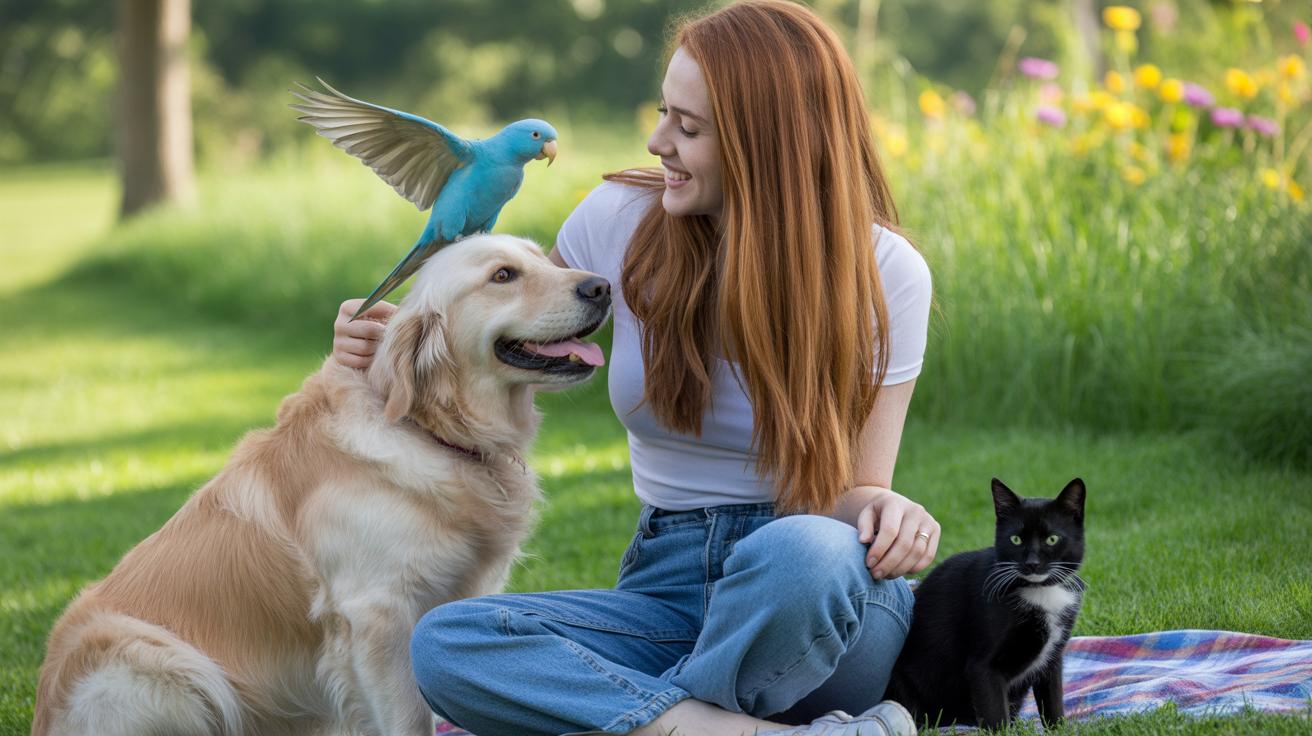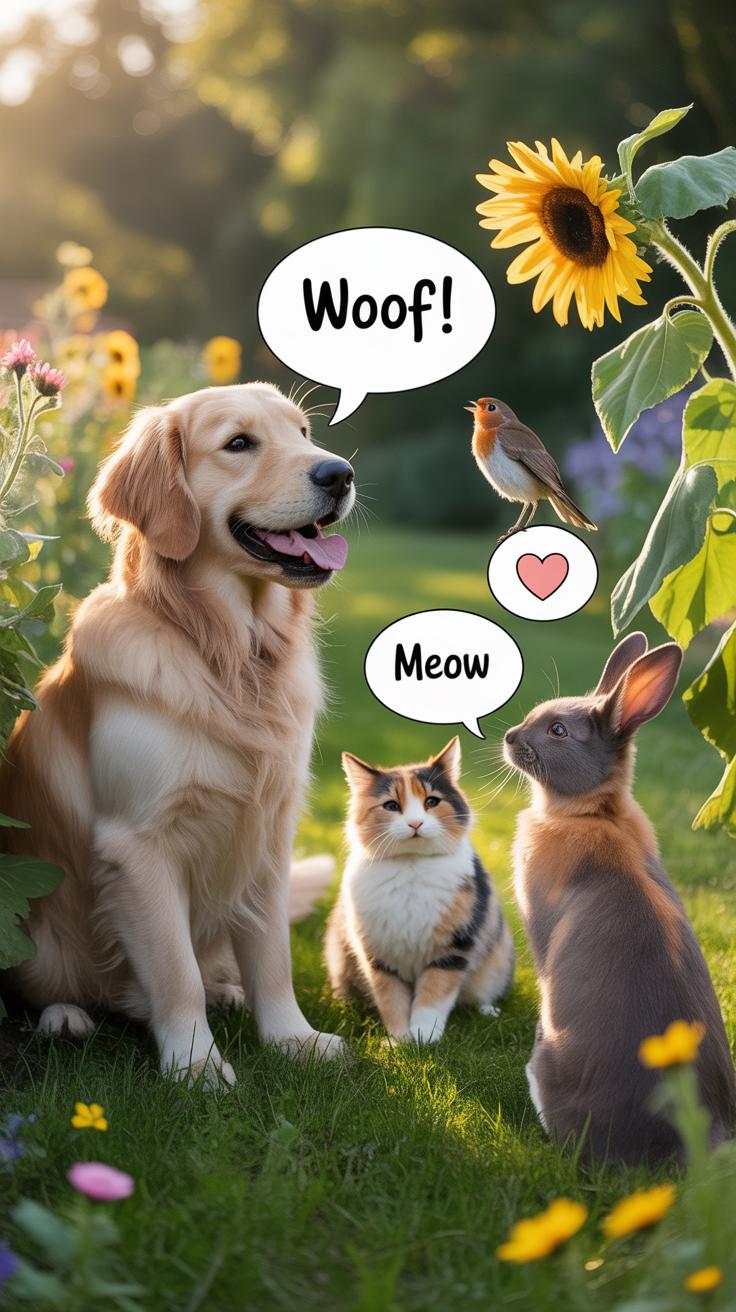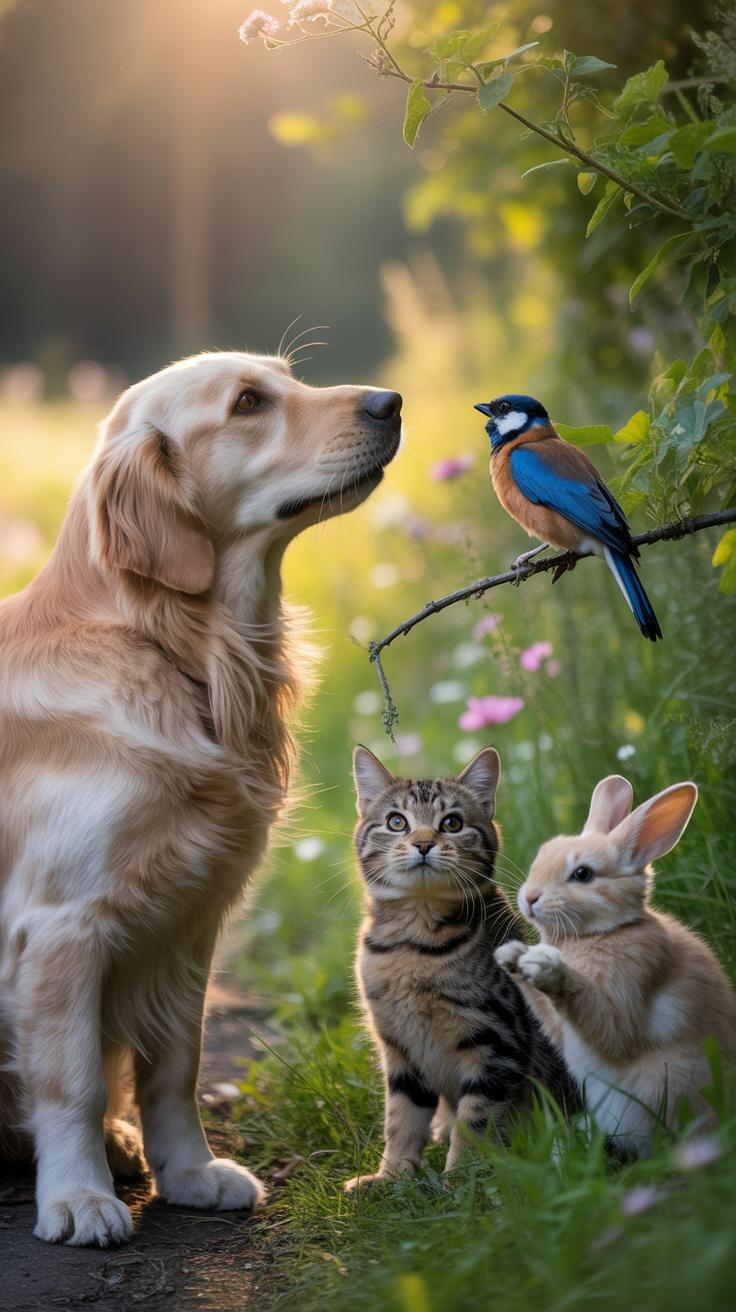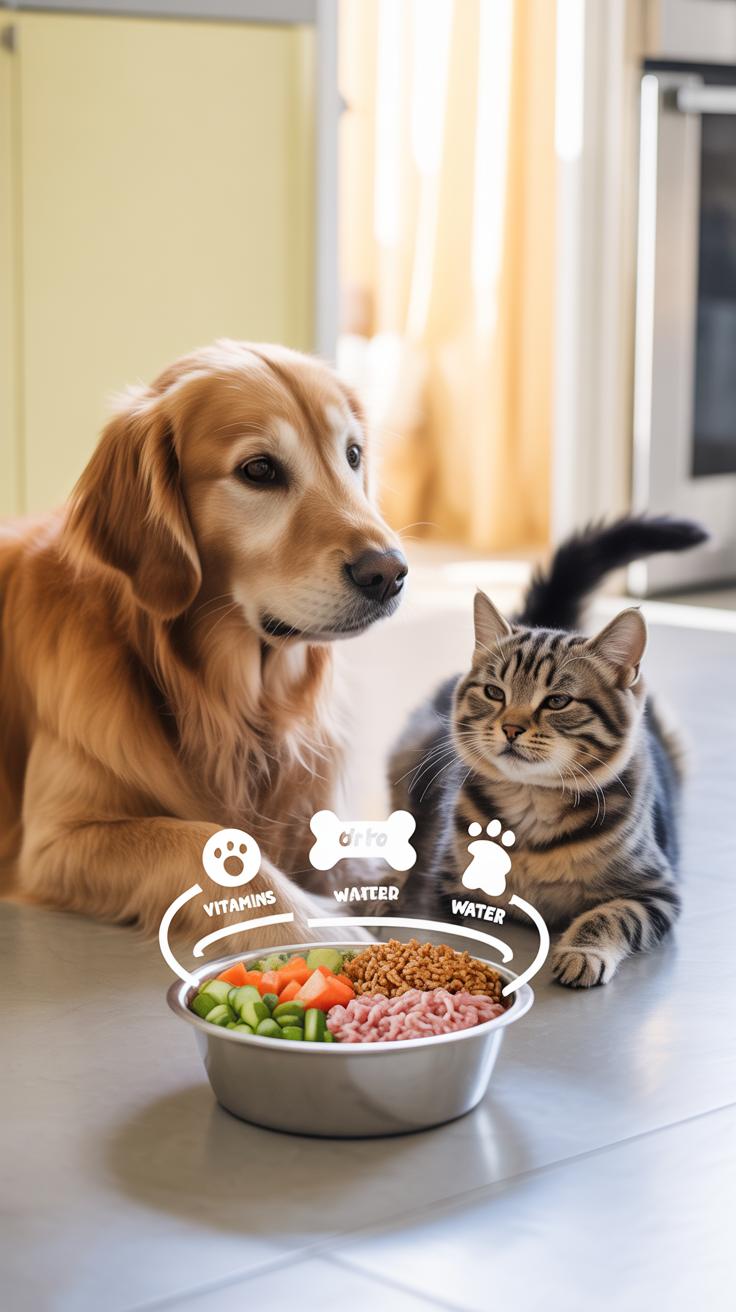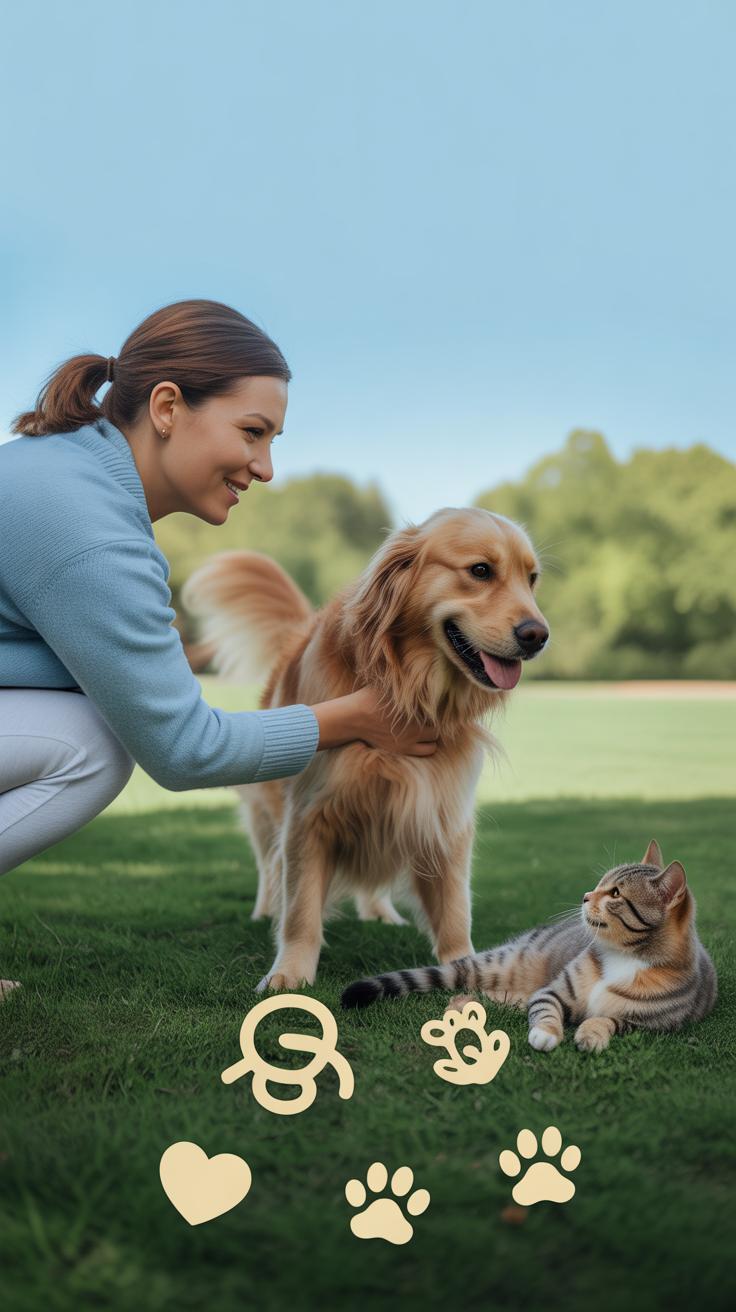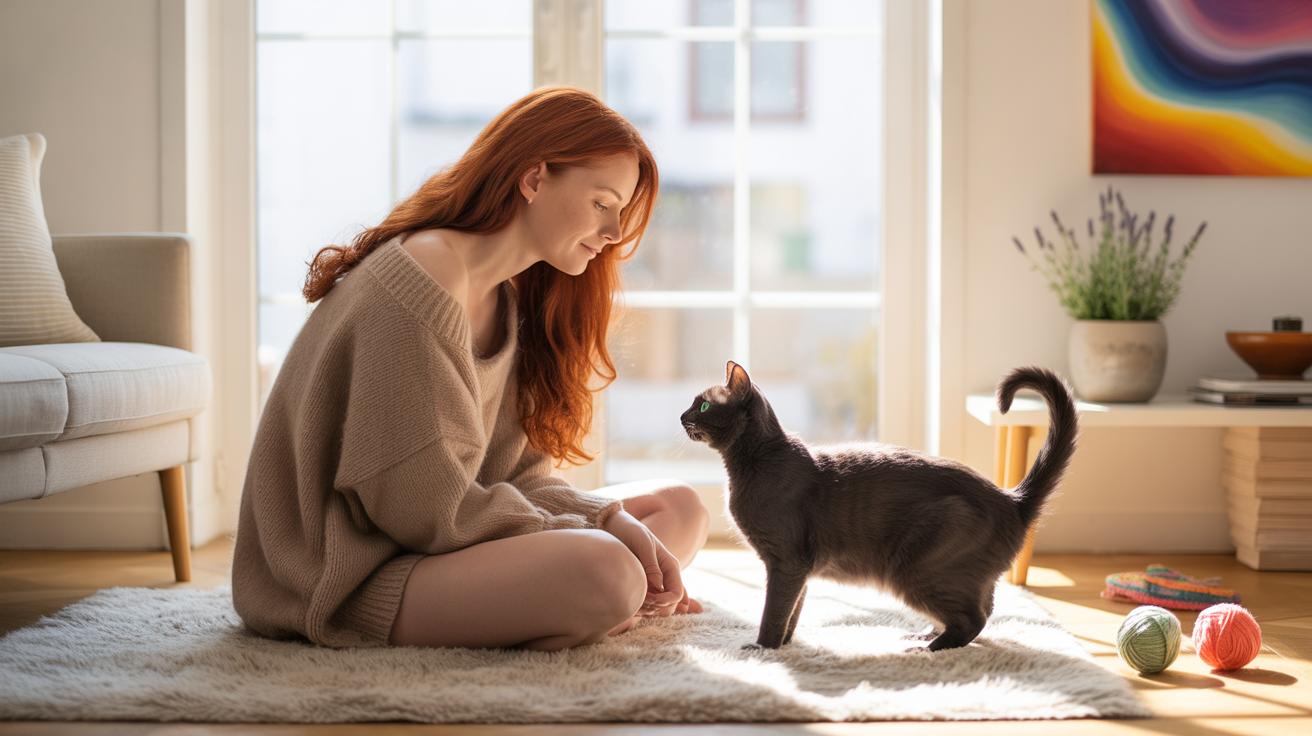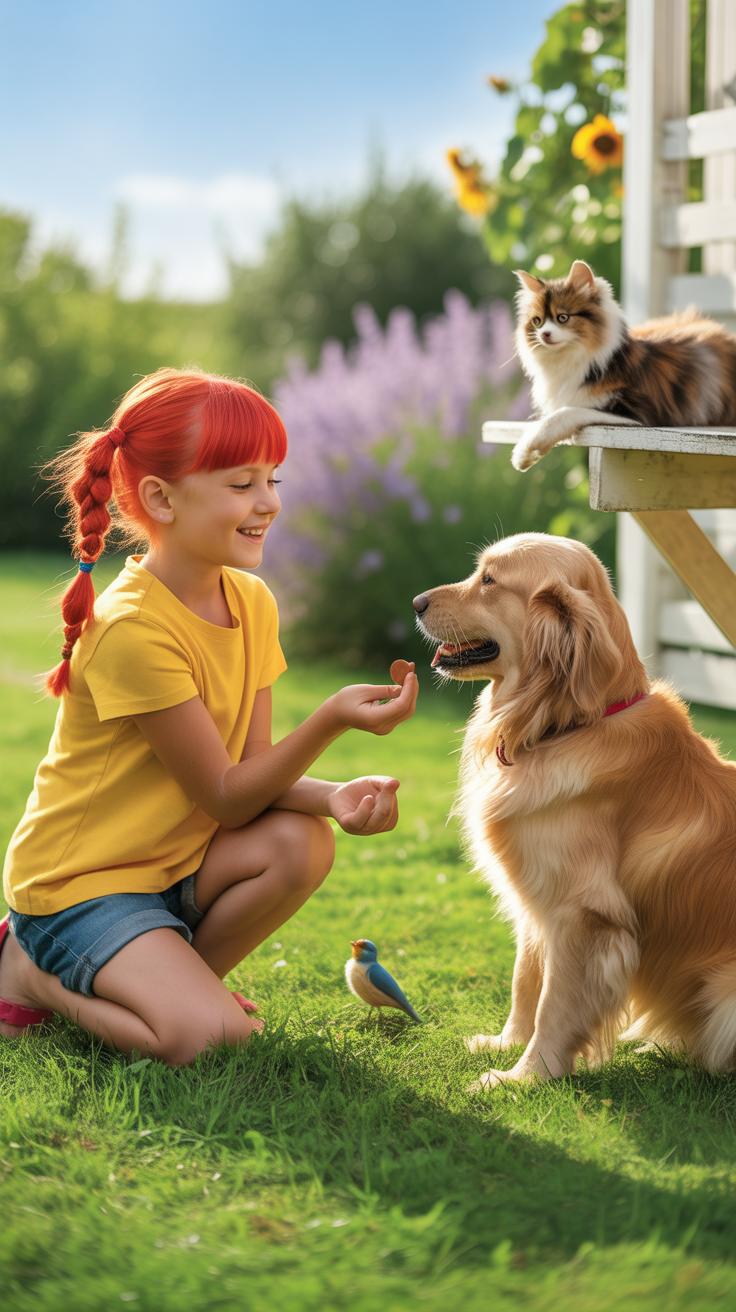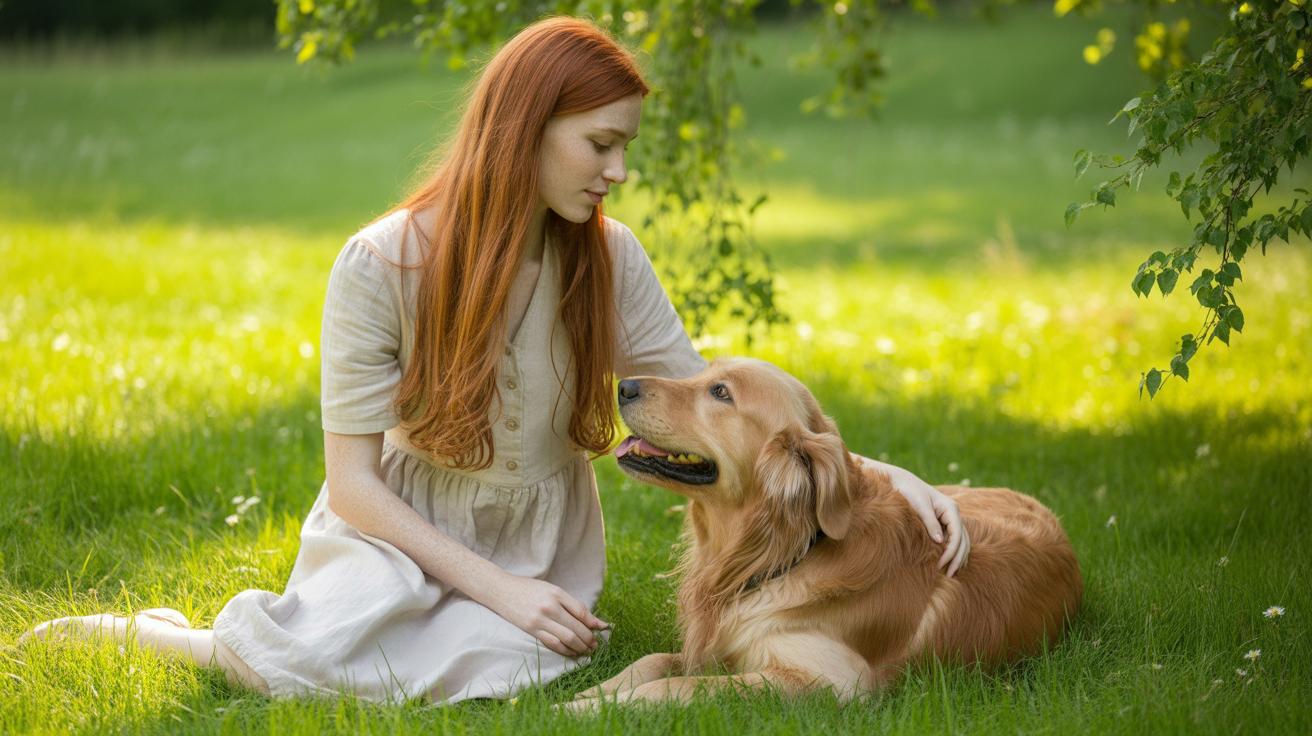Introduction
Animals are part of our daily lives, and understanding them can improve our relationship with our pets. This article covers animal facts that help you understand your pet better, making your bond stronger and life easier for both of you. You’ll find helpful insights into your pet’s behavior, emotions, senses, and needs.
By exploring how animals communicate, what they eat, how they feel, and how to care for and train them, you can provide better care and enjoy a happier life together. Each chapter offers clear examples and practical advice that you can use every day to meet your pet’s needs and understand their actions.
How Animals Communicate and What It Means
Animals communicate with their owners and other pets in ways that go beyond just sounds. You might notice your dog’s bark changes depending on the situation—sharp and alert if there’s a stranger, softer and more inviting when greeting you. Cats often use meows differently too: a short meow might mean “hello,” but a drawn-out one could suggest they want attention or food. Even purring can signal different feelings, like contentment or sometimes stress.
Body language is equally telling. Tail wagging doesn’t always mean happiness; a fast wag with a stiff tail might hint at agitation, while slow wagging could mean uncertainty. Ear positions are subtle but important—ears pinned back often show fear or submission, while perked ears mean alertness or interest.
By paying close attention to these sounds and gestures, you get a clearer sense of what your pet is trying to express. This helps you respond in ways that suit their needs better, whether it’s calming a nervous dog or giving a cat the space they want. I’ve found myself guessing wrong a few times, only to realize the tail wag wasn’t happiness but an anxious signal. It’s a learning process, for sure, but noticing these cues can deepen your relationship—and even prevent misunderstandings or accidents.
Try watching your pet quietly for a few minutes, noting the sounds they make and their body language. It’s almost like learning a new language, and I think most pet owners find it rewarding once they start to understand those little signals. What moments have you noticed where your pet’s communication truly surprised you?
Animal Senses and How They Affect Behavior
What Your Pet Can Sense Differently
Your pet experiences the world quite differently from you. Take dogs, for instance—their sense of smell is so fine-tuned it can detect odors in concentrations nearly 100 million times lower than humans can. Sometimes, I wonder if they live in a scent-based world that we can barely imagine. This heightened smelling ability explains why dogs spend so much time sniffing during walks or investigating objects in the home. They’re gathering information invisible to us.
Cats, on the other hand, rely heavily on their vision, especially in low light. They see better in the dark due to a special layer behind their retinas called the tapetum lucidum. You might notice your cat prowling confidently at dusk or dawn, or seemingly fascinated by faint movements you cannot see.
Other senses matter too. Dogs and cats both have sharper hearing than humans, able to catch high-pitched sounds. This might explain sudden bursts of barking or pouncing when you think nothing’s around.
Senses and Everyday Pet Actions
Think about your dog reacting the moment a mail carrier drops off letters or when a distant siren calls out. That reaction starts with hearing tuned to pick up far more than we do. Maybe your dog’s alert behavior isn’t just random noise, but a real recognition of something important.
For cats, their hunting instincts come alive when they chase a moving toy or even a shadow. It’s not just play; they’re practicing skills linked to vision and motion detection, hardwired from their wild relatives.
Understanding these sensory triggers helps explain why pets behave a certain way. When your dog paws at the door or your cat suddenly darts, think: what scent, sound, or sight caught their attention? It’s rarely just whimsy. If you watch carefully, you begin to read their world on a sensory level—you might even start to predict reactions before they happen.
Nutrition Facts for a Healthy Pet
What Makes a Balanced Diet for Pets
Dogs and cats need a balance of proteins, fats, and carbohydrates to stay healthy, but their requirements aren’t exactly the same. Cats, as obligate carnivores, depend heavily on protein and certain vitamins like taurine, which they can’t produce on their own. Dogs tolerate more carbs but still rely on good-quality protein to maintain muscles and energy.
Proteins repair tissues and support growth, while fats offer a concentrated energy source and aid in nutrient absorption. Carbs provide quick energy but too many can lead to weight issues. Vitamins and minerals round out the diet, supporting immune health, bone strength, and even coat condition. For example, calcium and phosphorus keep bones strong, while vitamins A and E contribute to skin and eye health.
Tips to Choose the Right Food and Treats
Picking pet food can feel overwhelming. Look for foods listing real meat as the first ingredient, especially for cats. For dogs, whole grains and veggies can be part of a good diet, but watch for fillers like corn or wheat that offer little nutrition. Always compare labels rather than just prices; cost doesn’t guarantee quality, but really cheap food often skews away from the best nutrition.
When it comes to treats, keep them occasional and small. Treats should never exceed 10% of your pet’s daily calorie intake. Overfeeding treats can upset digestion, cause weight gain, or even trigger picky eating habits. Also, consider your pet’s activity level. A highly active dog might need more calories, while an older or less active pet requires fewer.
It’s tricky sometimes—your dog may beg during walks, and you might want to give in, but balancing portion sizes keeps their energy steady and reduces health risks. Have you noticed your cat getting less playful after switching foods? Sometimes simple adjustments in diet can improve energy and mood.
Understanding Pet Emotions and Mental Health
Pets don’t talk, but they sure express feelings. When your dog wags its tail or your cat purrs, that’s happiness. Fear can show up as trembling, hiding, or refusal to eat. Stress might be less obvious—restlessness or excessive licking, for instance. It’s easy to overlook how much mental health shapes your pet’s daily life, yet it matters as much as their physical health. Think about it: an anxious dog may refuse to eat, and a stressed cat might stop using the litter box.
Recognizing Your Pet’s Feelings
Some signals are pretty clear while others need a bit more attention. For positives, watch for:
- Tail wagging or relaxed body posture
- Playfulness and willing interaction
- Soft eyes and slow blinking, especially in cats
Signs of distress or negative emotions include:
- Hiding or avoiding contact
- Growling, hissing, or raised fur
- Excessive panting or pacing
- Loss of appetite or withdrawal
Recognizing these can be tricky—what’s fear for one might just be shyness for another. That nuance can complicate understanding your pet’s real state.
Supporting Your Pet’s Emotional Well-being
Creating a sense of safety is key. For anxious pets, try:
- Consistent routines to reduce uncertainty
- Quiet spaces where they can retreat comfortably
- Gentle play and positive reinforcement
- Slow, calm interactions rather than overwhelming attention
Boost happiness by engaging regularly—whether it’s a simple walk or interactive toys. But don’t force affection; pets need control too. Sometimes, giving space is the best comfort. Do you ever wonder if your pet feels overwhelmed by your attempts to help? It’s a delicate balance.
Ultimately, watching their behavior thoughtfully and adjusting your approach can build emotional security, which leads to healthier and happier pets. Mental and physical health aren’t easily separated—they feed into each other in ways we often miss.
Basic Pet Care Everyone Should Know
Daily Care Routines to Keep Pets Happy
Feeding your pet on a consistent schedule helps keep their digestion stable and their energy steady. It’s easy to overlook, but varying meal times or types too much can upset them. Simple routines, like feeding twice a day for most dogs or regulated portions for cats, often work best. Don’t forget fresh water—pets can be picky about it sometimes, so check the bowl regularly.
Exercise isn’t just about burning energy; it prevents boredom and helps your pet stay mentally sharp. Walks, playtime, or interactive toys work wonders. Even short bursts of activity matter, especially for indoor pets. I’ve noticed when my dog skips his morning walk, he gets a bit restless—maybe your pet reacts too?
Grooming is more than appearance. Brushing your pet removes loose hair and can alert you to skin issues early. Depending on the animal, the frequency shifts—some dogs may need daily brushing, while short-haired cats might barely need it. Nail trimming and dental care also sneak into this routine. It’s a chance to bond, but don’t push too hard if your pet resists.
Monitoring Health Signs at Home
Learning to spot small changes in your pet’s behavior or body can make a big difference. Look for signs like reduced appetite, changes in energy, coughing, or unusual scratching. Sometimes pets hide discomfort well, but things like excessive licking or restlessness hint something’s off. It’s easy to miss subtle signs if you aren’t paying close attention.
You might wonder whether a limp or a slightly runny nose calls for a vet visit. If symptoms persist more than a day or worsen, it’s safer to check with a professional. Trust your instincts; if your pet seems “off,” even in small ways, getting advice early helps avoid bigger problems later. Remember, health monitoring isn’t just about sickness—it includes mental well-being, so keep an eye on mood shifts too.
How to Train Your Pet Effectively
Training your pet is less about strict rules and more about building a connection—one that makes daily life smoother for both of you. Positive reinforcement, which means rewarding good behavior rather than punishing mistakes, really works. It might sound obvious, but consistency in this approach is key. If you only sometimes reward your pet for the same behavior, they get confused or even frustrated. Think about it this way: pets, like people, respond better when they know what to expect.
Training isn’t just about commands; it’s a way to understand what your pet needs and how they learn. You might notice your dog sits faster when you use treats, or your cat approaches more when you speak softly before offering a toy. These small moments build trust. I’ve seen dogs that used to ignore their owners start complying happily just because they get a bit of praise and a treat afterward. It changes the relationship—no doubt about that.
Simple Training Techniques Everyone Can Use
Start with easy commands like “sit,” “stay,” or “come.” Keep sessions short—say 5 to 10 minutes—because longer might tire your pet or make them lose focus.
Here are some easy steps:
- Choose a quiet place without distractions.
- Say the command clearly and calmly.
- Wait a moment for your pet to respond.
- Immediately reward with a treat, toy, or gentle praise.
- Repeat a few times, then take a break before trying again.
It sounds simple, but sticking to these steps makes a big difference. Sometimes pets won’t respond right away, and that’s okay—if they don’t get it today, maybe tomorrow.
Fixing Common Behavioral Issues
Pets often show unwanted behaviors like barking, scratching, or chewing things they shouldn’t. These usually have reasons behind them—boredom, anxiety, or simply habits picked up over time. Training combined with small changes in the environment can often help.
Try these ideas:
- For excessive barking, first identify triggers. Then, teach “quiet” by rewarding silence after a command.
- Scratching furniture? Provide a scratching post or a similar outlet, and praise your pet when they use it.
- If your pet chews objects, give them toys meant for chewing and keep tempting items out of reach.
Patience matters here. You may have to repeat the process several times, and sometimes pause and rethink your approach. Does your pet get enough exercise? Could stress be involved? Tackling behavior isn’t just about stopping bad habits; it’s about understanding your pet’s needs better.
How Animals Use Their Instincts in Daily Life
Pets rely on instincts every day, even if they seem calm or well-behaved. These natural behaviors are hardwired, shaped by survival needs from their wild ancestors. For example, dogs might dig in the yard or chew on things, not just out of boredom but because hunting or digging were key survival skills once. Cats stalk and pounce during play, mimicking hunting even though their meals come from a bowl. You might wonder why your pet suddenly bursts into a “zoomies” sprint or scratches the couch. Those are instincts bubbling up, expressing energy or marking territory.
Instincts Pets Still Use
Many common pet actions trace back to instinct:
- Digging: Dogs often dig to hide food or create a den-like spot, even if you don’t see the logic in a backyard.
- Stalking and pouncing: Cats’ play mimics hunting, helping develop coordination and focus.
- Chewing and mouthing: Puppies explore and soothe teething through chewing, but it also relates to how wild canines test objects.
- Territorial marking: Urine marking or rubbing scents is a way to claim space.
Understanding these behaviors as instinct can make those destructive moments less frustrating. They aren’t just being difficult—there’s a natural urge behind them.
Balancing Instincts with Training
Training doesn’t erase instincts; it guides them. You can create outlets for natural behaviors, like providing digging boxes or puzzle feeders that engage a dog’s searching instincts. A cat tower lets your feline express climbing and scratching urges without ruining your furniture. At the same time, gently steering these instincts to fit in your home keeps everyone happier. Sometimes you might need patience here—your pet isn’t ignoring commands out of stubbornness but following instinct too strongly. When training respects their nature, it often becomes more effective and less stressful.
Have you ever thought about how much patience it takes to balance these natural urges with what your home needs? It’s a bit of a back-and-forth, and sometimes you might have to adjust your expectations. But acknowledging instincts is half the battle in being a thoughtful, understanding pet owner.
The Role of Veterinary Care in Pet Longevity
Why Regular Veterinary Checkups Matter
Taking your pet to the vet regularly isn’t just for when something’s obviously wrong. In fact, consistent vet visits help catch problems early—sometimes before you even notice signs. It’s kind of like how we go for routine health exams, even if we feel fine. These checkups support your pet’s long-term health and can actually add years to their life.
Preventive care plays a big role here. Vaccinations protect pets from dangerous diseases that might otherwise go unnoticed until it’s too late. Treatments, such as parasite control or dental cleanings, keep common but serious health issues at bay. Skipping these might seem okay at times, but it often comes with hidden risks.
What to Expect in Routine Vet Visits
Even if your pet looks perfectly healthy, vets still perform thorough exams. They’ll check weight, listen to the heart and lungs, inspect eyes and ears, and feel the body for lumps or irregularities. Blood tests or urine samples might be taken to reveal underlying conditions that pets can’t show outwardly. Sometimes, small issues hint at bigger ones later on.
Vaccinations usually happen on these visits, along with discussions on diet, behavior, or exercise. You may think a quick check is enough between annual visits, but vets often recommend more frequent visits, especially as pets age or encounter new environments. So those regular appointments? They’re more than just routine—they’re a critical layer of care.
How Prevention Helps Avoid Serious Illness
Think about diseases like rabies, distemper, or parvovirus in dogs and cats. These are preventable, thanks to vaccines. Missing vaccinations can open doors to infections that are hard and expensive to treat. Fleas, ticks, and heartworms also pose threat—these parasites can cause long-term damage, but timely medication keeps them away.
Some illnesses build up slowly and silently, like kidney disease or diabetes. Regular vet checks help spot early signs and make managing these easier. I know it’s tempting to skip appointments when your pet seems “fine,” but that’s exactly when prevention counts the most. Keeping a health schedule is a small effort that pays off in a big way.
Building a Strong Bond with Your Pet
Understanding your pet’s unique traits can shape how you interact with them every day. When you learn about their behavior, preferences, and needs, it feels like you’re tuning into their world. This, honestly, makes the connection more genuine—not just you talking, but actually listening, even if they can’t use words. Maybe your dog’s tail wag means something different depending on the situation, or your cat’s silent stare is a request for attention. Small insights like these build trust slowly but surely.
Daily actions matter. Try greeting your pet with calm energy instead of rushing or fussing. Spend a few minutes observing their mood before trying to engage. Petting, scratching behind the ears, or simply sitting near them can create a comforting routine you both appreciate. It’s not complicated but consistency counts more than anything dramatic. These quiet rituals let your pet know you care beyond food and play.
Activities That Strengthen Your Connection
Simple, interactive activities can deepen your relationship. Consider these:
- Throwing a ball or playing fetch stimulates your dog’s mind and body, creating shared fun.
- Teaching basic commands like “sit” or “come” offers gentle challenges and rewards your pet’s attention.
- Using puzzle feeders or treat-dispensing toys encourages problem-solving and keeps things fresh.
- Quiet moments, like brushing your cat or just sitting together, build comfort without overwhelming.
Sometimes, just watching your pet explore or nap nearby builds a quiet form of companionship. These moments are easy to overlook but mean a lot. Would your pet want more play or relaxation? Balancing both keeps you connected in different ways.
Why Your Pet Depends on You Emotionally
Your pet doesn’t just rely on you physically—for shelter, food, or health—they also look to you for emotional safety. They respond to your mood, sense your presence, and often feel calmer when you’re nearby. That’s a big responsibility, and also, a unique joy. Knowing you can comfort a scared or lonely pet is powerful.
Think about how your dog might curl up close during thunderstorms or how a cat seeks you out on a bad day. They depend on you to be steady, patient, and kind. Sometimes, that can be tiring or confusing when pets test limits, but it’s part of the relationship’s depth. Caring for a living being means accepting uneven days and unpredictable moods—with the reward of genuine companionship that can feel very deep, maybe deeper than people often realize.
Conclusions
Understanding animals through their communication, senses, nutrition, and emotions helps you become a better pet owner. You learn to meet your pet’s needs wisely and respond to their behavior clearly. This knowledge creates a happier environment for your pet and strengthens your everyday interactions.
Taking care of your pet goes beyond feeding and grooming. Seeing things from your pet’s point of view, offering proper nutrition, training, health care, and emotional support ensures a long, joyful life together. This journey of learning deepens your bond and makes every day with your pet more rewarding.

